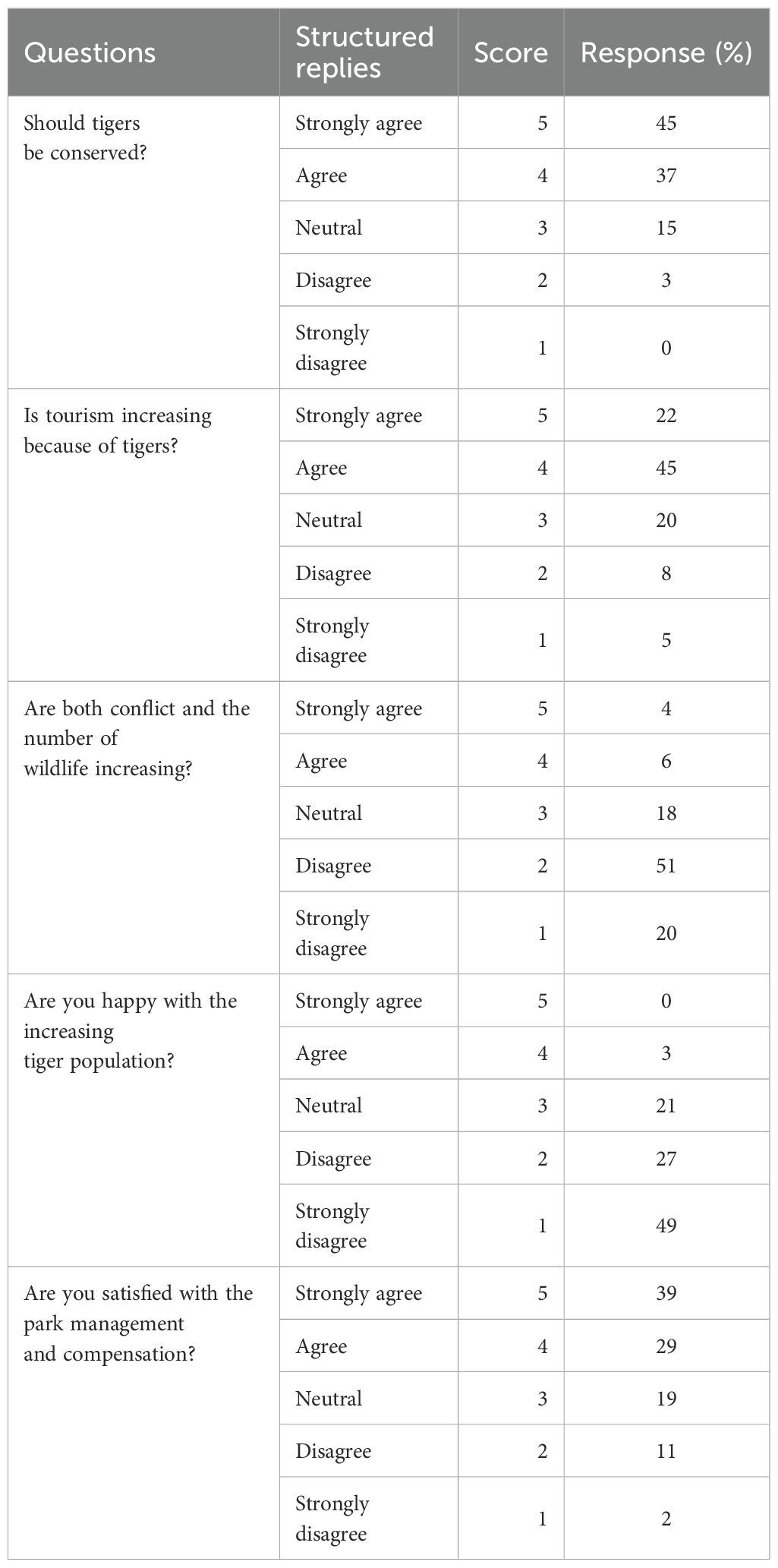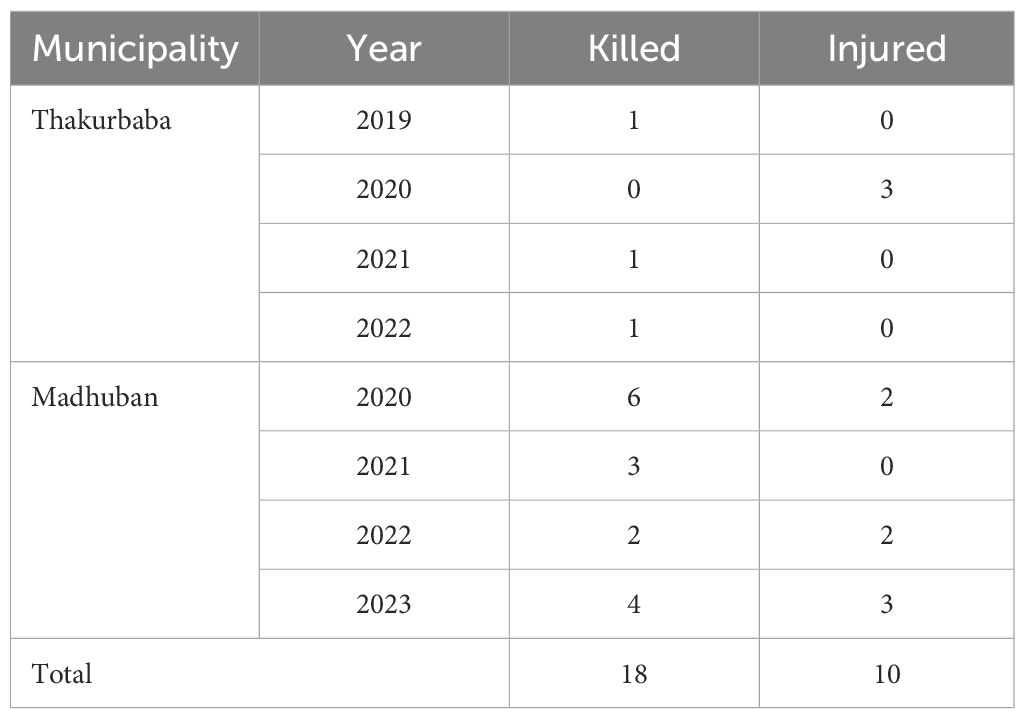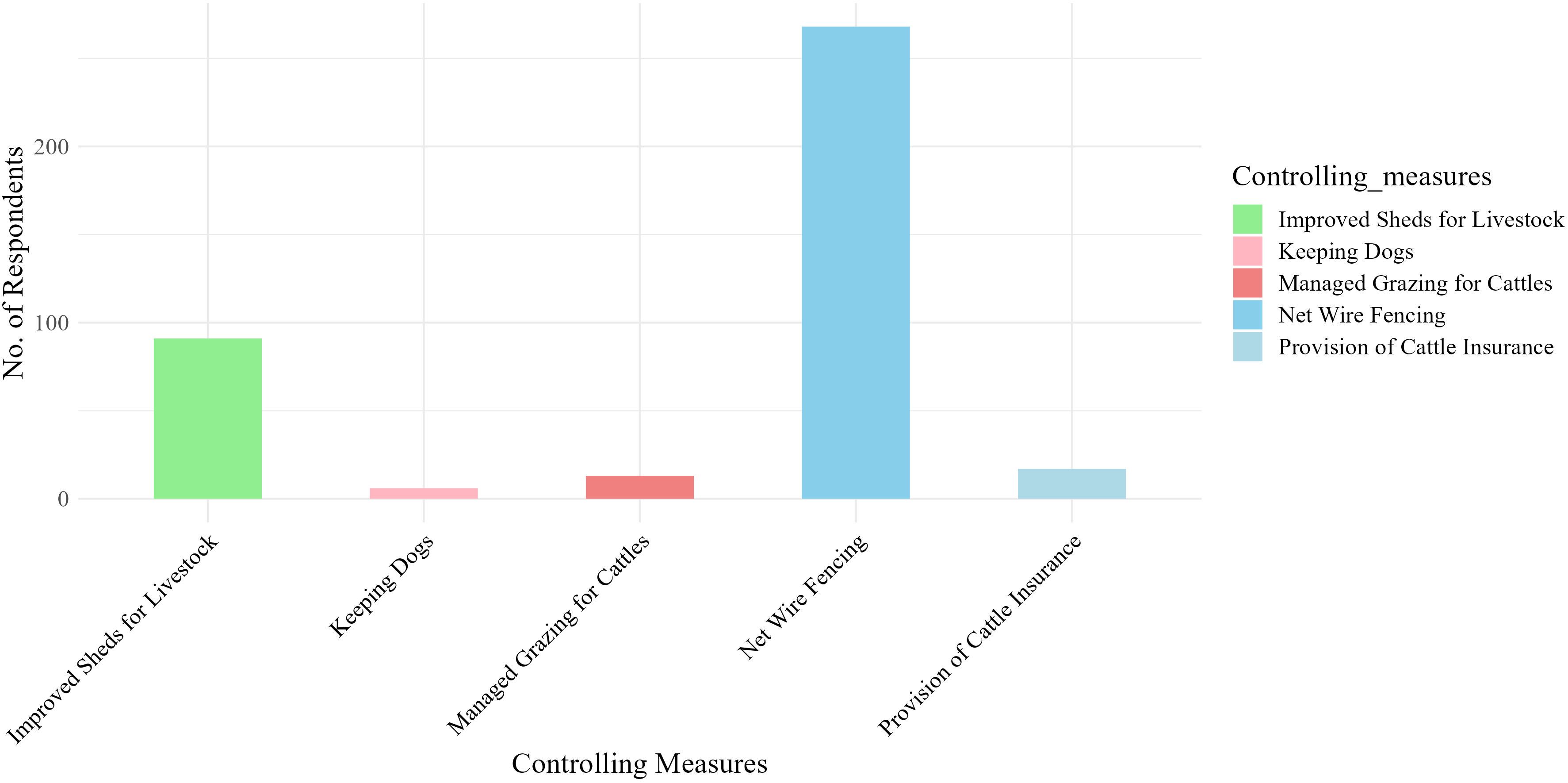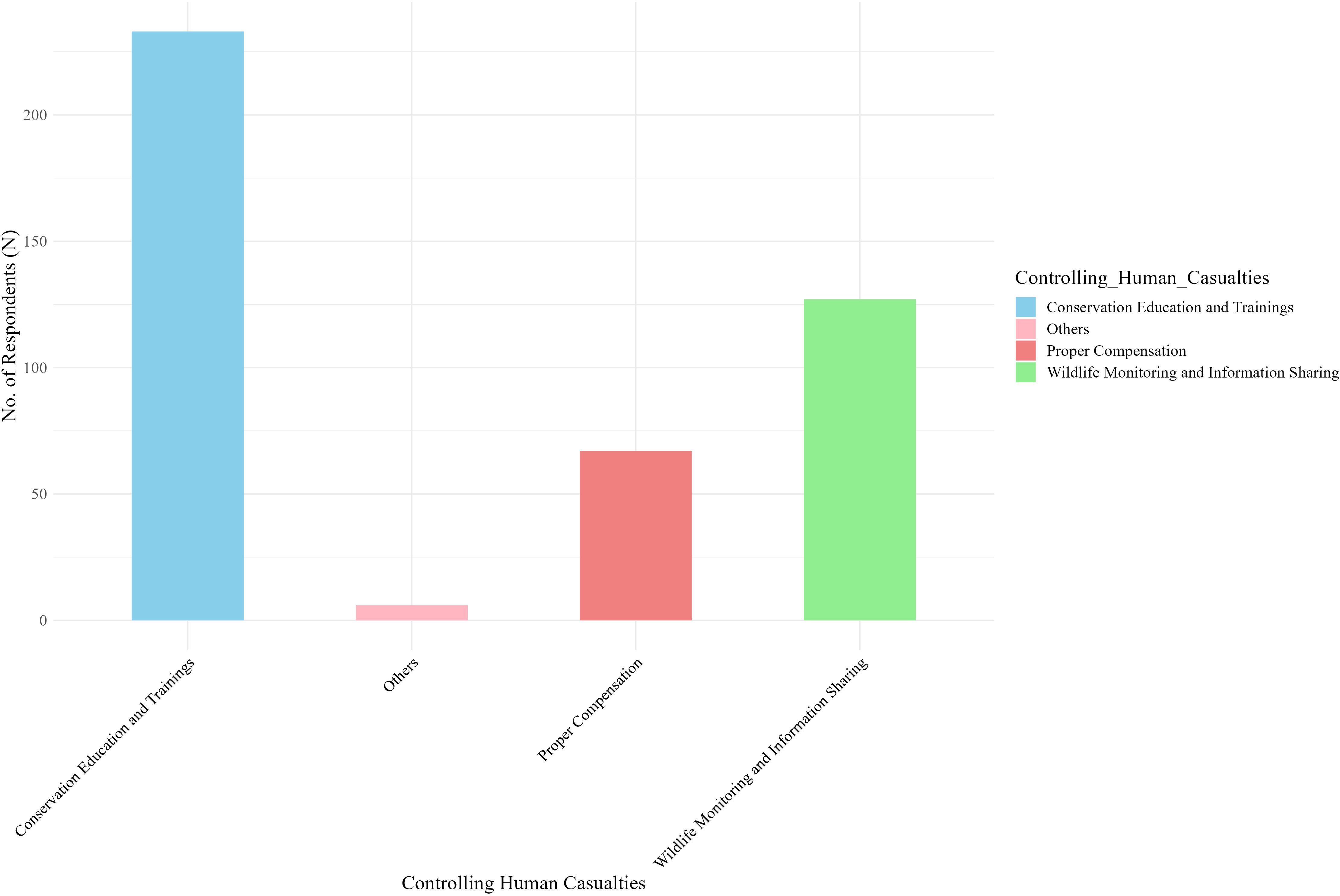- 1Faculty of Applied Ecology, Agricultural Sciences and Biotechnology, University of Inland Norway, Koppang, Norway
- 2National Trust for Nature Conservation (NTNC), Lalitpur, Nepal
Human–tiger conflict (HTC) is one of the rising issues of Bardiya National Park (BNP) and is receiving attention from conservation biologists. This study emphasizes the extent of human–tiger conflict in two municipalities, Thakurbaba and Madhuban, in the buffer zone of Bardiya National Park, Nepal. Primary and secondary information was collected to determine the socio-economic characteristics relevant to tiger conservation following a questionnaire survey of the community people. A semi-structured questionnaire was randomly administered to 438 households to generate information from the respondents, along with these people’s perceptions toward tigers and their interest in tiger conservation. The Likert scale was used to assess respondents’ attitudes, while a chi-square test of homogeneity and logistic regression analysis were employed to determine the best-fitting model and identify significant variables influencing perceptions toward tiger conservation. A total of 18 people were killed and 10 were injured by tigers between 2019 and 2023. The people’s perception of tigers and their conservation was significantly associated with socio-economic variables, including gender, ethnicity, economic status, and source of income. We found female, low-income, and Janajati respondents likely to have negative attitudes toward their conservation. The Likert scale responses revealed strong overall support for tiger conservation and perceived tourism benefits. In addition to the ever-growing human–tiger conflict, people are aware of tiger conservation and suggest that making net wire fences, providing improved sheds for cattle, and cattle insurance schemes help to minimize Livestock depredation events; effective training on wildlife monitoring and awareness programs could be among the best ways to mitigate conflicts between humans and tigers.
1 Introduction
Large carnivores, despite occurring in lower densities (Karanth and Chellam, 2009), are highly involved in conflicts with humans, which reduces carnivore populations through active persecution based on real or perceived threats to themselves or their livestock (Graham et al., 2005; Inskip and Zimmermann, 2009; Goodrich et al., 2011). Human–wildlife conflict (HWC) has been one of the most significant conservation issues in recent years, exacerbated by increasing human populations, loss of natural habitats, and, in some cases, increased wildlife populations due to successful conservation programs (Sethy, 2013). Human–tiger conflict (HTC) is generally expressed in four forms: i) tiger attacks on humans, ii) tiger attacks on livestock, iii) threats to human safety from tigers living near human settlements, and iv) retaliatory killings of tigers (Goodrich, 2010; Bhattarai et al., 2019).
Two decades of conservation success in Nepal have led to a rapid increase in the tiger population (DNPWC and DFSC, 2022). The tiger population in Nepal was estimated at 121 individuals in 2009 (Karki et al., 2009), 198 in 2013 (Dhakal et al., 2014), 235 in 2018 (DNPWC and DFSC, 2018), and 355 in 2022 (DNPWC and DFSC, 2022), indicating an almost tripling of the population between 2009 and 2022. In recent years, there has been an increase in reported incidences of HTC. These incidents typically involve the depredation of livestock and attacks on humans trespassing into the park area or in the fringe area for the forest resources (Bhattarai and Fischer, 2014; Dhungana et al., 2022; Gurung et al., 2008; Paudel et al., 2024). Additionally, incidents of tiger mortalities arising from territorial disputes among male tigers have been reported in national parks (Bhatt et al., 2023; Kadariya et al., 2023).
In Nepal, Bardiya National Park (BNP), home to 125 tigers (DNPWC and DFSC, 2022), is ecologically connected to Banke National Park (BaNP) in the east, which harbors 25 tigers (DNPWC and DFSC, 2022). It is also connected to India’s Katarniaghat Wildlife Sanctuary (KWS) in the south with 59 tigers (Qureshi et al., 2023) through the Khata forest corridor, which forms one of the priority Tiger Conservation Landscapes of the Indian Subcontinent (Wikramanayake et al., 1998). As Nepal’s second-largest national park with an increasing tiger population (DNPWC and DFSC, 2022), BNP serves as the source population for the surrounding landscapes of Nepal and India (Sanderson et al., 2010).
Protected areas (PAs) cover 23.39% of the total land (DNPWC, 2022), where a high density of local communities dependent on natural resources live alongside PAs (Heinen et al., 2019), particularly in Nepal’s plains. BNP also has a high human population density (Government of Nepal, 2022). Along with the increasing tiger population, HTC is also on the rise in BNP and its associated forests (Kadariya et al., 2023). In the decade leading up to 2019, there were no human fatalities related to HTC—an important element of conservation success in the Bardiya region (Fitzmaurice et al., 2021). However, between September 2020 and May 2021, there were approximately 10 human fatalities due to tiger attacks within BNP (Rauniyar, 2021). According to park authorities, 12 people were killed in the park region during the fiscal year 2021/2022 (DNPWC, 2022). Community people who have benefited from PAs are active in management initiatives, are less reliant on natural resources, and are more likely to have a positive attitude toward tiger conservation (Dewu and Røskaft, 2018; Karanth and Nepal, 2012; Mutanga et al., 2015). Conversely, higher livestock losses, greater reliance on natural resources, and incidents of human attacks lead to negative attitudes toward tigers and their conservation among local people (Baral and Heinen, 2007; Mutanga et al., 2015). Such attitudes and retaliatory killings can seriously undermine conservation efforts (Aryal et al., 2015; Carter et al., 2014; Singh et al., 2015). Although all countries are affected by HWC, developing countries like Nepal are more vulnerable than developed nations since livestock and agriculture are important parts of rural livelihood (Khanal et al., 2022; Luitel, 1999).
In addition to a scientific understanding of wildlife conflicts, the attitudes of local people toward wildlife are critical for managing the conflict (Naughton-Treves and Treves, 2005). To ensure that wildlife management policies are effective and sensitive to local conditions, it is important to understand social factors, such as the attitudes of local people, which provide an overview of the cultural and sociopolitical context of human–wildlife conflicts (Kideghesho et al., 2007). Assessing local people’s attitudes can provide insight into how they will behave, how they comply with wildlife protection regulations, how they respond to economic losses caused by wildlife, and the degree to which they are willing to coexist with wildlife (Megaze et al., 2017).
This study investigates the socio-economic factors influencing local attitudes toward tigers and their conservation in the buffer zone of BNP, Nepal. By identifying key variables associated with positive or negative perceptions, the research aims to inform targeted conservation strategies that promote coexistence, reduce conflict, and support long-term tiger population sustainability.
2 Methods
2.1 Study area
The study was carried out in two municipalities in the buffer zone of BNP, Thakurbaba and Madhuban, in mid-western Nepal. Thakurbaba municipality covers an area of approximately 104.5 km2, while Madhuban municipality spans approximately 135.1 km2. BNP (28°23′N 81°30′E), with an area of 968 km2, is the largest protected area in the Terai region of Nepal, listed in Terai Arc Landscape (TAL) (BNP, 2022; Wikramanayake et al., 1998). The landscape of the study area spans from 152 m at Manaughat to 1,564 m at Baspani above mean sea level, predominantly characterized by flat lowlands. The vegetation cover within BNP and its buffer zone is primarily composed of forests (76%), followed by cultivated land (13.48%), shrubland (3.64%), sandy areas (3.42%), water bodies (1.63%), grasslands (1.47%), barren land (0.16%), swampy areas (0.15%), orchards (0.02%), and river cuttings/cliffs (0.01%) (BNP, 2022). The area falls within two bioclimatic zones—the lower tropical zone (below 500 m) and the higher tropical zone (501–1,564 m)—experiencing a subtropical monsoon climate characterized by four distinct seasons: summer (March–May), monsoon (June–August), autumn (September–November), and winter (December–February) (Odden and Wegge, 2005).
Rich in biodiversity, BNP harbors 839 species of flora and numerous endangered large mammals such as the Asian elephant (Elephas maximus), greater one-horned rhinoceros (Rhinoceros unicornis), and tigers, alongside a total of 61 mammalian species, 513 bird species, 52 herpetofauna species, and 121 fish species (BNP, 2022). The buffer zone is inhabited by a diverse population, including Indigenous communities like the Tharu, as well as Brahmin, Chhetri, and Thakuri, and Dalit, who reside in economically disadvantaged conditions (National Statistics Office, 2021). The human population density in Thakurbaba municipality is approximately 473 persons per square kilometer, with a total of 11,469 households. Similarly, Madhuban municipality has 391 persons per square kilometer, with 12,444 households (Central Bureau of Statistics, 2022). The local economy is almost completely based on farming with extensive irrigation systems (Prins et al., 2022). The western section of BNP has been characterized by relatively high densities of both natural prey and livestock (Upadhyaya et al., 2020).
2.2 Data collection method
A semi-structured questionnaire survey was used to obtain data on people’s perceptions of tigers and their interest in tiger conservation (Supplementary Material 1). In total, 438 household surveys (168 Thakurbaba and 270 Madhuban) were included. Interviews were conducted primarily with the head of the household, although other family members often participated to formulate a collective response. In the absence of the head of the family, another family member who is over 18 was interviewed. All questions were closed-ended for ease of quantitative analyses. Interviews were conducted in participants’ homes in January and February 2022, and each interview lasted 30–45 minutes.
Data on human casualties and injuries (2019–2023) because of HTC were retrieved from BNP and the National Trust for Nature Conservation (NTNC). Secondary data were also collected through a comprehensive review of various sources, including published and unpublished literature, books, articles, annual reports, and relevant online websites.
2.3 Data analysis
We collected both quantitative and qualitative data from the study sites. We performed chi-square tests to find any significant difference in the local community’s attitudes toward tigers and their conservation with socio-economic variables like gender, age, ethnicity, source of income, economic status, and landholding size.
To examine attitudes, we formulated five structured questions (Table 1). We used a 5-point Likert-type ordinal scale (coded as 1, 2, 3, 4, or 5) to assess the attitudes of the community people (Likert, 1932; Spiteri and Nepalz, 2006), with responses coded as follows: 1 = strongly disagree, 2 = disagree, 3 = neutral, 4 = agree, and 5 = strongly agree toward tiger conservation. To further investigate the factors influencing community interest in tiger conservation, we employed a binary logistic regression model, as the dependent variable, “interests in tiger conservation”, was recoded into a binary format (0 = not interested, 1 = interested). This approach allowed for the estimation of unbiased and efficient coefficients for the explanatory variables. The model included ethnicity, gender, age group, education, source of income, and the ability to differentiate tigers from leopards (yes/no) as independent variables. We performed all the statistical analyses using R (R Core Team, 2022).
3 Results
3.1 Socio-economic characteristics
We surveyed a total of 438 households in Madhuban and Thakurbaba municipalities, which are two of the five municipalities in the buffer zone of Bardiya National Park (Figure 1). The majority of the respondents were male [70% (n = 305)], while only 30% (n = 133) were female. Similarly, the age group of between 41 and 60 years accounted for the largest portion of the survey respondents [43% (n = 189)], followed by the 20–40 years age group with 38% (n = 167), 61–80 years with 18% (n = 78), and above 80 years with only 1% (n = 4). Most respondents were Tharu [54% (n = 235)], as they have a high population density within the study area, followed by Brahmin, Chhetri, and Thakuri (BCT) [32% (n = 140)] and Dalit [14% (n = 63)]. The majority of the respondents were literate [32% (n = 142)], with 32% (n = 139) having passed the School Leaving Certificate (SLC)/Secondary Education Examination (SEE) and 11% (n = 49) having completed the intermediate level. The remaining 25% (n = 108) were illiterate. The primary occupation of respondents was daily wage labor, accounting for 51% (n = 223) of the total surveyed population. This included employment as drivers, tourist guides, kitchen helpers, and cooks in hotels. Agriculture was the second most common livelihood, involving 32% (n = 140) of respondents. A small proportion of individuals [3% (n = 11)] operated their own business, such as homestays and restaurants, and 3% (n = 11) were engaged in foreign employment, contributing to household income through remittances. Government employment was reported by 8% (n = 37). The remaining 4% (n = 16) were involved in rearing animals, with cows, buffalos, goats, hens, and oxen as the major livestock reared by the people of the study area. Similarly, 64% (n = 279) of the respondents had taxable land, while 36% (n = 159) had non-taxable land for agricultural activities.

Figure 1. Map of the study area showing respondents’ locations and land use/land cover (LULC) classification within the study area in 2022.
3.2 Human–tiger conflict
Over 5 years (2019–2023), a total of 18 people were killed and 10 people were injured by tigers (Table 2). The study area recorded several incidents of livestock depredation caused by tigers. Livestock depredation incidents totaled 198, including 116 buffalos, 32 goats, 29 cows/oxen, and 21 sheep killed by tigers in Madhuban and Thakurbaba municipalities (Figure 2).
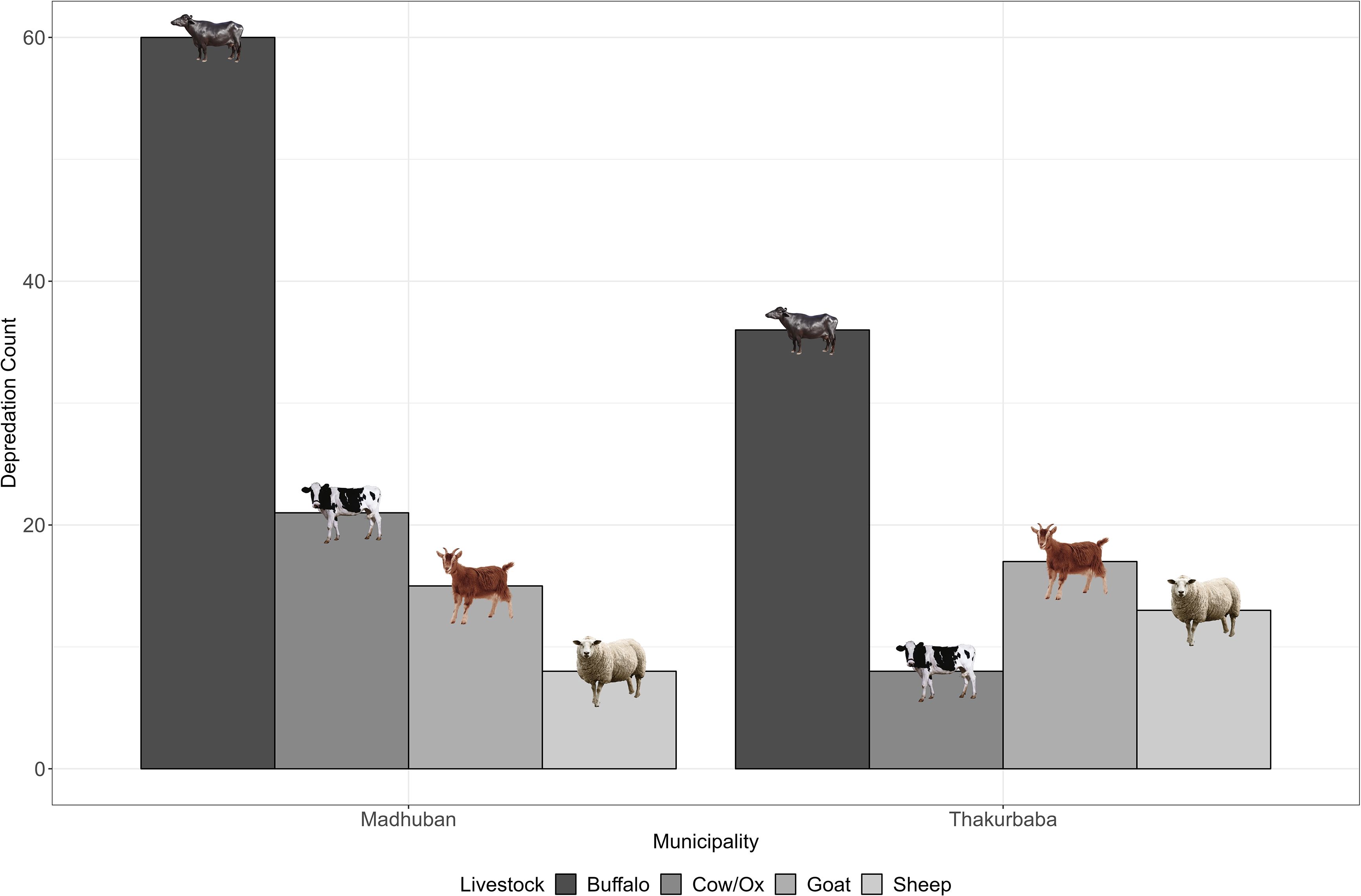
Figure 2. Livestock depredation caused by tigers in Thakurbaba and Madhuban municipalities between 2017 and 2022.
3.3 People’s attitudes/perceptions toward tiger conservation
The results of the study revealed that the majority of the respondents [71% (n = 313)] had a positive attitude toward tiger conservation. A significantly higher percentage of men [70% (n = 305)] were interested in tiger conservation compared with women [30% (n = 133)] (χ2 = 7.05, df = 1, p < 0.05) (Table 3). This could be because men are more involved in conservation programs, community organizations, and wildlife-related professions, whereas women are more likely to visit forests for daily necessities. The study also found a positive relationship between the respondents’ ethnicity and their attitudes toward tiger conservation (χ2 = 10.24, df = 2, p < 0.05) (Table 3), as most of the people belonging to the Tharu ethnic group, who are engaged in the conservation sector, benefit from tiger ecotourism. Similarly, the study revealed that the respondents’ source of income (χ2 = 15.71, df = 5, p < 0.05) and their economic status also positively influence the attitudes toward tiger conservation (χ2 = 9.81, df = 3, p < 0.05) (Table 3), as tiger ecotourism has the potential to provide a sustainable income for many local people in the future.
To assess attitudes of the community people, five Likert scale questions were posed to respondents (n = 438) regarding various aspects of tiger conservation (Table 1). The majority of the respondents expressed strong support for tiger conservation, with 45% strongly agreeing and 37% agreeing that tigers should be protected. Additionally, 67% (22% strongly agree and 45% agree) believed that tourism has increased due to the presence of tigers. However, attitudes were more mixed regarding human–wildlife conflict and park management. Only 10% acknowledged that both wildlife and conflict are increasing, while a large portion either disagreed (51%) or strongly disagreed (20%) with this statement. Respondents were also divided in their views on the rising tiger population: 76% expressed negative sentiments, with only 3% agreeing and none strongly agreeing. On park management and relief mechanism, responses were generally positive, with 68% reporting satisfaction.
Table 4 shows that livelihood vulnerability led to negative attitudes. Respondents involved in animal husbandry exhibited the strongest negative attitudes (β = −1.97, p < 0.05), followed by daily wage laborers (β = −0.66, p < 0.05). Similarly, ethnicity significantly influenced attitudes, with Janajati (predominantly Tharu) showing reduced support compared to the BCT reference group (β = −0.62, p < 0.05). Gender disparities emerged, with men more supportive than women (β = 0.47, p = 0.05). Conversely, ecological knowledge—the ability to differentiate tigers from leopards—strengthened support (β = 0.59, p < 0.05).
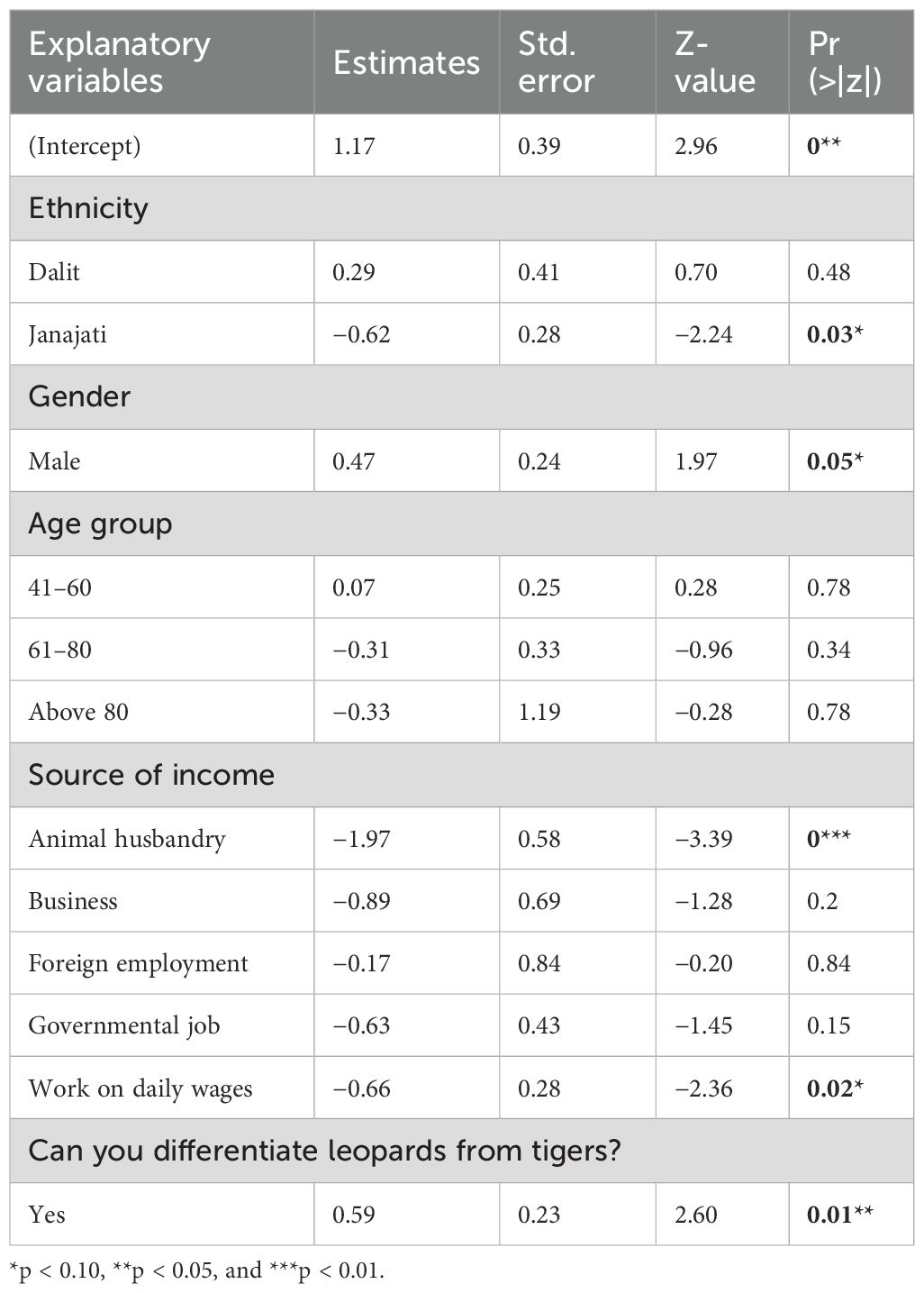
Table 4. The determinants of respondents' (N = 438) attitudes toward tiger conservation based on Tobit regression models.
3.4 Control measures
This study found that a large percentage of respondents [74% (n = 324)] do not have a predator-proof corral house, and only a few [26% (n = 114)] had a predator-proof house (χ2 = 100.68, df = 1, p < 0.05). The community members tended to keep their livestock in open fields. Moreover, 65% (n = 285) of respondents believed that everyone was responsible for tiger conservation, 22% (n = 96) believed that park officials were responsible, 11% (n = 48) believed that the government was responsible, and 2% (n = 9) believed that the local community was responsible (χ2 = 409.73, df = 3, p < 0.05). Additionally, 62% (n = 270) were dependent on the community forest for livestock fodder, 23% (n = 101) were dependent on the national park, and only 15% (n = 67) of the respondents were using their private land for fodder collection for the livestock. Respondents recommended various measures to control livestock depredation, including making net wire fences [68% (n = 268)], providing improved sheds for cattle [23% (n = 91)], managing grazing for cattle [3% (n = 13)], offering cattle insurance [4% (n = 17)], and keeping dogs in the house [2% (n = 6)] (χ2 = 625.24, df = 4, p < 0.05) (Figure 3).
The results of our study indicate that most people believe that the best way to prevent human casualties caused by wildlife is by offering conservation and education training to the local people [54% (n = 233)]. This was followed by conducting wildlife monitoring and information sharing programs [29% (n = 127)] and providing adequate compensation to victims [15% (n = 67)]. A small percentage of respondents mentioned other techniques as a solution to this issue [2% (n = 6)] (χ2 = 259.31, df = 3, p < 0.05) (Figure 4).
Based on the findings, most respondents [48% (n = 215)] cited the potential for tourism development in their region as the primary motivation for conservation efforts. A smaller percentage of respondents [15% (n = 66)] mentioned the endangered status of tigers as a reason for conservation, while 22% (n = 96) highlighted the role of tigers in maintaining ecosystem balance. A small portion of respondents [5% (n = 22)] were motivated by the beauty of tigers, and 9% (n = 39) (χ2 = 267.5, df = 4, p < 0.05) considered religious beliefs as their reason for conservation efforts.
4 Discussion
Our study presents the most in-depth analysis of people’s attitudes toward tigers and their conservation in Bardiya National Park. Although Bardiya National Park experiences severe human–wildlife and human–tiger conflicts, social factors shaping an individual’s position in society had a greater influence on attitudes toward tigers than direct negative experiences with tigers. We found a significant influence of gender, ethnicity, source of income, and economic status. The finding is comparable to reports of positive attitudes toward tigers of the majority of the local people in Nepal (Dhungana et al., 2022) and Central India (Reddy and Yosef, 2016).
In the case of gender, women were more likely to have negative attitudes toward tigers and their conservation than men (Carter and Allendorf, 2016; Doubleday and Rubino, 2022). Paudel et al. (2024) mentioned that in 2019–2023 in the Bardiya–Banke Complex, a total of 76 human attacks by wildlife were recorded, of which 42% were on female individuals. Because of such a high number of attacks, women may feel that they are more vulnerable, and they have developed negative attitudes toward wildlife conservation. Similarly, studies in Chitwan National Park (CNP), another prominent tiger-bearing park in Nepal, found that women may develop negative attitudes toward tigers due to a lack of control over their interactions with them (such as being forced to enter forests to gather necessary natural resources) and limited perspectives on the advantages of doing so (Carter et al., 2014). Similarly, Doubleday and Rubino (2022) investigated if and how perceptions of tiger reintroductions are disparate among women and men living in and around Sariska Tiger Reserve in India and reported the clear gendered delineations in perceptions, where male participants predominantly focused on economic and ecological benefits, and female participants highlighted threats to personal safety. The local community around BNP in the study has a positive attitude toward tiger conservation. However, in CNP, Dhungana et al. (2016, 2022) found that many of the local people have negative attitudes toward tigers. Our result indicates that age is not a significant factor in attitudes toward tiger conservation, mirroring the results reported by Dhunagana et al. (2022) in CNP.
The higher caste (BCT) shows a positive attitude toward tiger conservation, which coincides with findings by Carter et al. (2014) and Dhungana et al. (2022). This also corroborates the finding of Heinen (1993) in Koshi Tappu Wildlife Reserve, Nepal, where higher-caste Hindus were more supportive of wildlife conservation. Additionally, in India, nomadic hunting tribes (often lower social strata) were involved in killing tigers, partly due to economic pressure and cultural practices (Malviya et al., 2022). However, Bhattarai et al. (2013) concluded that Tharu Janjati show a more positive attitude toward forest and resource conservation, which contradicts our findings. As the Tharu are the native residents and have been involved in the early stages of tiger conservation, and also because of their dependency on the forest, they are more vulnerable to tiger attacks, which may lead them to develop a negative attitude toward tiger conservation. Our study found a significant link between education and attitudes toward tiger conservation, while Shahi et al. (2023) observed a positive association. Similarly, in Kenya, the education level did not correlate with attitudes toward elephant conservation (Gadd, 2005). Also, Malviya et al., 2022 concluded that in India, education was inversely related to negative opinions about tiger conservation, while Carter et al. (2014) and Dhungana et al. (2022) highlighted education’s crucial role in tiger conservation in Chitwan National Park.
Community people are very interested in protecting tigers, even though human–tiger conflicts are rising. This positive view may come from their town’s “Tigerland” reputation and the revenue they make from tiger tourism (Gurung et al., 2008; Karanth and Nepal, 2012; Carter et al., 2012; Bhattarai and Fischer, 2014; Carter and Allendorf, 2016; Pudasaini, 2020). Notably, economic status positively affected attitudes toward tiger conservation, similar to the findings reported by Dhungana et al. (2022). We assume that the positive attitudes of well-off families may have mainly stemmed from their better access to conservation awareness, education, conservation benefits, and relief payments, as well as their enhanced capacity to cope with potential costs of tiger conservation. Since education can foster greater tolerance toward carnivores by shaping attitudes through rational thinking (Woodroffe et al., 2005) and expanding understanding of predator conservation (Espinosa and Jacobson, 2012), it is essential to strengthen conservation education programs, particularly for illiterate and less-educated communities living near the park.
Our study found that over 50% of the respondents were involved in daily wage work, such as guiding, driving, and other tourism-related activities. Indeed, 71% of local people are in favor of tiger conservation, indicating that the local people in the study area are more likely to be engaged in and benefit from ecotourism activities. They get seasonal employment in lower-paid positions, particularly as housekeepers and cooks in hotels, and this supports the positive attitudes of the community people toward tiger conservation. However, Shahi et al. (2023) observed that in BNP, the community had negative attitudes because of conflict with the park staff and military guards, as well as ineffective service delivery from the national park office. Due to the community’s heavy reliance on agriculture and livestock rearing, the short-term impact indicates that individuals who farm cows, buffalos, ducks, chickens, sheep, or goats are experiencing greater economic losses due to human–wildlife conflict.
The dependency on the park resources also influenced residents’ attitude (Shahi et al., 2023), but despite their high dependence on forest resources, community people had a positive attitude toward tiger conservation. However, Shahi et al. (2023) concluded that the community had a negative attitude toward the park management. Also, retaliatory killing of tigers has been reported in other tiger-occupied landscapes (Miquelle et al., 2005; Goodrich et al., 2011; Dhungana et al., 2016). However, in BNP, no retaliatory killing of tigers has been recorded up to 2024, despite a sevenfold increase in the tiger population and a high density of 7.15 (SD 0.38) by 2022 (DNPWC and DFSC, 2022). This exemplifies how community engagement and perceived benefits can mitigate conflict, providing a compelling blueprint for other carnivore-dense landscapes across South and Southeast Asia. With the increasing tiger population and high tiger density, this may lead to a rise in human–wildlife conflict in the near future if conservation efforts are not undertaken. Our study also concluded that human–tiger conflict is becoming very high, as in 5 years, a total of 18 individuals were killed and 10 people were injured. Despite the escalating human–tiger conflicts, the local community’s remarkable (71%) positive attitude toward tiger conservation offers a critical pathway for coexistence. This increasing conflict in BNP mirrors a pressing challenge for tiger conservation and the wellbeing of rural communities across tiger-bearing landscapes (Goodrich, 2010).
The study found that local respondents believe that conservation education, wildlife monitoring training, net wire fences, and fair relief payments are essential. These measures, also suggested by Kadariya et al. (2023), are seen as crucial for fostering human–wildlife coexistence and maintaining ecological balance. To achieve sustainable carnivore conservation, particularly for iconic species like tigers, a broader, multi-faceted approach is imperative. While our study is based on a limited sample size of households (n = 438) and identified key socio-demographic factors, future research must delve deeper into the causative factors shaping these perceptions and critically examine how the equitable access to and distribution of conservation benefits directly influence stakeholders’ attitudes. Incorporating the perspectives of a wider array of stakeholders, including local government bodies, community-based organizations, and non-governmental organizations, is essential for crafting comprehensive conservation strategies that transcend local boundaries. The insights from Bardiya National Park highlight that genuine coexistence between humans and large carnivores is not an idealistic goal but an achievable reality, contingent upon understanding the complex interplay of social, economic, and ecological factors, and fostering a shared vision where both human wellbeing and biodiversity thrive.
Data availability statement
The original contributions presented in the study are included in the article/Supplementary Material. Further inquiries can be directed to the corresponding author.
Ethics statement
Ethical approval was not required for the studies involving humans because the data were collected using anonymous, voluntary questionnaires focused solely on perceptions and socio-economic information. No sensitive personal data were gathered, and all participants provided informed verbal consent prior to participation. The studies were conducted in accordance with the local legislation and institutional requirements. Written informed consent for participation was not required from the participants or the participants’ legal guardians/next of kin in accordance with the national legislation and institutional requirements because no personally identifiable or sensitive information was collected, and participation was entirely voluntary. Verbal consent was obtained from all respondents prior to the survey, in line with local cultural practices and ethical norms.
Author contributions
PS: Methodology, Writing – review & editing, Formal analysis, Data curation, Writing – original draft, Conceptualization. RK: Conceptualization, Funding acquisition, Writing – review & editing, Investigation, Methodology, Supervision. NS: Methodology, Conceptualization, Writing – review & editing, Investigation, Validation, Supervision, Funding acquisition. UP: Writing – review & editing, Methodology, Data curation, Investigation. RBKC: Writing – original draft, Formal analysis, Methodology, Writing – review & editing, Investigation, Data curation, Conceptualization.
Funding
The author(s) declare that no financial support was received for the research and/or publication of this article.
Acknowledgments
We would like to thank the National Trust for Nature Conservation–Bardiya Conservation Program (NTNC–BCP) for the technical support and field data collection.
Conflict of interest
The authors declare that the research was conducted in the absence of any commercial or financial relationships that could be construed as a potential conflict of interest.
Generative AI statement
The author(s) declare that no Generative AI was used in the creation of this manuscript.
Any alternative text (alt text) provided alongside figures in this article has been generated by Frontiers with the support of artificial intelligence and reasonable efforts have been made to ensure accuracy, including review by the authors wherever possible. If you identify any issues, please contact us.
Publisher’s note
All claims expressed in this article are solely those of the authors and do not necessarily represent those of their affiliated organizations, or those of the publisher, the editors and the reviewers. Any product that may be evaluated in this article, or claim that may be made by its manufacturer, is not guaranteed or endorsed by the publisher.
Supplementary material
The Supplementary Material for this article can be found online at: https://www.frontiersin.org/articles/10.3389/fcosc.2025.1623056/full#supplementary-material
References
Aryal A., Ji W., Shrestha U. B., Bencini R., and Raubenheimer D. (2015). Factor people into tiger conservation. Nature 522, 287–287. doi: 10.1038/522287a
Baral N. and Heinen J. T. (2007). Resources use, conservation attitudes, management intervention and park-people relations in the Western Terai landscape of Nepal. Environ. Conserv. 34, pp.64–pp.72. doi: 10.1017/S0376892907003670
Bhatt T. R., Castley J. G., Sims-Castley R., Baral H. S., and Chauvenet A. L. (2023). Connecting tiger (Panthera tigris) populations in Nepal: Identification of corridors among tiger-bearing protected areas. Ecol. Evol. 13, p.e10140. doi: 10.1002/ece3.10140
Bhattarai B. R. and Fischer K. (2014). Human–tiger Panthera tigris conflict and its perception in Bardia National Park, Nepal. Oryx 48, pp.522–pp.528. doi: 10.1017/S0030605313000483
Bhattarai S., Pant B., and Upadhyaya C. P. (2013). Dependency of Tharu communities on wild plants: A case study of Shankarpur, Kanchanpur district. Banko Janakari 21, pp.35–pp.40. doi: 10.3126/banko.v21i1.9062
Bhattarai B. R., Wright W., Morgan D., Cook S., and Baral H. S. (2019). Managing human-tiger conflict: lessons from Bardia and Chitwan National Parks, Nepal. Eur. J. Wildlife Res. 65, 34. doi: 10.1007/s10344-019-1270-x
BNP (2022). Management Plan of Bardia National Park and its Buffer Zone (FY 2079/80 -2083/84) (Thakurdwara, Bardia: Bardia National Park Office). Available online at: https://dnpwc.gov.np/media/publication/Management_Plan_of_Bardia_National_Park_and_Its_Bufferzone_2022.pdf.
Carter N. H. and Allendorf T. D. (2016). Gendered perceptions of tigers in chitwan national park, Nepal. Biol. Conserv. 202, 69–77. doi: 10.1016/j.biocon.2016.08.002
Carter N. H., Riley S. J., and Liu J. (2012). Utility of a psychological framework for carnivore conservation. Oryx 46, pp.525–pp.535. doi: 10.1017/S0030605312000245
Carter N. H., Riley S. J., Shortridge A., Shrestha B. K., and Liu J. (2014). Spatial assessment of attitudes toward tigers in Nepal. Ambio 43, 125–137. doi: 10.1007/s13280-013-0421-7
Central Bureau of Statistics S. (2022). National Population Census 2021. Kathmandu, Nepal: National Statistics Office.
Dewu S. and Røskaft E. (2018). Community attitudes towards protected areas: insights from Ghana. Oryx 52, pp.489–pp.496. doi: 10.1017/S0030605316001101
Dhakal M., Karki (Thapa) M., Jnawali S. R., Subedi N., Pradhan N. M. B., Malla S., et al. (2014). Status of Tigers and Prey in Nepal (Kathmandu, Nepal: Department of National Parks and Wildlife Conservation). doi: 10.13140/2.1.3290.2407
Dhungana R., Maraseni T., Silwal T., Aryal K., and Karki J. B. (2022). What determines attitude of local people towards tiger and leopard in Nepal? J. Nat. Conserv. 68, 126223. doi: 10.1016/j.jnc.2022.126223
Dhungana R., Savini T., Karki J. B., and Bumrungsri S. (2016). Mitigating human-tiger conflict: An assessment of compensation payments and tiger removals in Chitwan National Park, Nepal. Trop. Conserv. Sci. 9, pp.776–pp.787. doi: 10.1177/194008291600900213
DNPWC (2022). Annual Report 2021/2022, Department of National Park and Wildlife Conservation. Available online at: https://dnpwc.gov.np/media/files/Annual_Report_2079_80.pdf (Accessed 8 February 2025).
DNPWC and DFSC (2018). Status of Tigers and Prey in NEPAL, Department of National Parks and Wildlife Conservation & Department of Forests and Soil Conservation (Kathmandu, Nepal: Ministry of Forest and Environment).
DNPWC and DFSC (2022). Status of Tigers and Prey in Nepal 2022 (Kathmandu, Nepal: Department of National Parks and Wildlife Conservation).
Espinosa S. and Jacobson S. K. (2012). Human-wildlife conflict and environmental education: Evaluating a community program to protect the Andean bear in Ecuador. J. Environ. Educ. 43, pp.55–pp.65. doi: 10.1080/00958964.2011.579642
Fitzmaurice A., Poudel P., Offord-Woolley S., Macdonald D., Thapa S., Lamichhane B. R., et al. (2021). Complex consequences of conservation success: Emerging human-tiger conflicts in Nepal. CatNews. 72, 23–27.
Gadd M. E. (2005). Conservation outside of parks: attitudes of local people in Laikipia, Kenya. Environ. Conserv. 32, pp.50–pp.63. doi: 10.1017/S0376892905001918
Goodrich J. M. (2010). Human–tiger conflict: a review and call for comprehensive plans. Integr. Zoology 5, pp.300–pp.312. doi: 10.1111/j.1749-4877.2010.00218.x
Goodrich J. M., Seryodkin I., Miquelle D. G., and Bereznuk S. L. (2011). Conflicts between Amur (Siberian) tigers and humans in the Russian Far East. Biol. Conserv. 144, pp.584–pp.592. doi: 10.1016/j.biocon.2010.10.016
Government of Nepal (2022). Preliminary Report of National Population 2021. Available online at:https://docs.censusNepal.cbs.gov.np//Documents/bc8e8395-e26e-4064-833b-d298e1d3a61c.pdf (Accessed 8 February 2025).
Graham K., Beckerman A. P., and Thirgood S. (2005). Human–predator–prey conflicts: ecological correlates, prey losses and patterns of management. Biol. Conserv. 122, pp.159–pp.171. doi: 10.1016/j.biocon.2004.06.006
Gurung B., Smith J. L. D., McDougal C., Karki J. B., and Barlow A. (2008). Factors associated with human-killing tigers in Chitwan National Park, Nepal. Biol. Conserv. 141, pp.3069–3078. doi: 10.1016/j.biocon.2008.09.013
Heinen J. T. (1993). Park–people relations in Kosi Tappu Wildlife Reserve, Nepal: a socio-economic analysis. Environ. Conserv. 20, 25–34. doi: 10.1017/S037689290003719X
Heinen J. T., Baral N., Paudel P. K., and Sah J. P. (2019). On the road to sustainability? A review of a half-century of biodiversity conservation successes in Nepal and some thoughts on future needs. IntechOpen, 1–17. doi: 10.5772/intechopen.84617
Inskip C. and Zimmermann A. (2009). Human-felid conflict: a review of patterns and priorities worldwide. Oryx 43, pp.18–pp.34. doi: 10.1017/S003060530899030X
Kadariya R., KC R. B., Paudel U., and Shrestha B. P. (2023). Behaviour change conservation campaign for improved human–tiger coexistence in Nepal. Oryx 57, pp.11–pp.11. doi: 10.1017/S0030605322001363
Karanth K. K. and Nepal S. K. (2012). Local residents perception of benefits and losses from protected areas in India and Nepal. Environmental Management 49 (2), 372–386.
Karanth K. U. and Chellam R. (2009). Carnivore conservation at the crossroads. Oryx 43, pp.1–pp.2. doi: 10.1017/S003060530843106X
Karki J. B., Jnawali S. R., Shrestha R., Pandey M. B., Gurung G., and Thapa M. M. (2009). Tigers and their prey base abundance in Terai Arc landscape (Nepal Kathmandu: Department of National Parks and Wildlife Conservation and Department of Forests). doi: 10.1007/s00267-011-9778-1
Khanal P., Dhakal R., Khanal T., Pandey D., Devkota N. R., and Nielsen M. O. (2022). Sustainable livestock production in Nepal: A focus on animal nutrition strategies. Agriculture 12, 679. doi: 10.3390/agriculture12050679
Kideghesho J. R., Røskaft E., and Kaltenborn BjørnP. (2007). Factors influencing conservation attitudes of local people in Western Serengeti, Tanzania. Biodiversity Conserv. 16, 2213–2230. doi: 10.1007/s10531-006-9132-8
Luitel C. (1999). Problems and policy issues of livestock raising in Nepal. Economic J. Nepal 22, 126–136. doi: 10.3126/ejon.v22i3.72378
Malviya M., Kalyanasundaram S., and Krishnamurthy R. (2022). Paradox of success-mediated conflicts: analysing attitudes of local communities towards successfully reintroduced tigers in India. Front. Conserv. Sci. 2, 783467. doi: 10.3389/fcosc.2021.783467
Megaze A., Balakrishnan M., and Belay G. (2017). Human–wildlife conflict and attitude of local people towards conservation of wildlife in Chebera Churchura National Park, Ethiopia. Afr. Zoology 52, pp.1–pp.8. doi: 10.1080/15627020.2016.1254063
Miquelle D., Nikolaev I., Goodrich J., Litvinov B., Smirnov E.V.G.E.N.Y., and Suvorov E.V.G.E.N.Y. (2005). Searching for the coexistence recipe: a case study of conflicts between people and tigers in the Russian Far East. Conserv. Biol. SERIES-CAMBRIDGE 9, 305.
Mutanga C. N., Vengesayi S., Muboko N., and Gandiwa E. (2015). Towards harmonious conservation relationships: A framework for understanding protected area staff-local community relationships in developing countries. J. Nat. Conserv. 25, 8–16. doi: 10.1016/j.jnc.2015.02.006
National Statistics Office (2021). National Population and Housing Census 2021 (Thapathali, Kathmandu: Government of Nepal).
Naughton-Treves L. and Treves A. (2005). “Socio-ecological factors shaping local support for wildlife: crop-raiding by elephants and other wildlife in Africa,” in People and Wildlife, Conflict or Co-Existence? Conservation Biology. Eds. Woodroffe R., Thirgood S., and Rabinowitz A. (New York: Cambridge University Press), 252–277.
Odden M. and Wegge P. (2005). Spacing and activity patterns of leopards Panthera pardus in the Royal Bardia National Park, Nepal. Wildlife Biol. 11, 145–152. doi: 10.2981/0909-6396(2005)11[145:SAAPOL]2.0.CO;2
Paudel U., KC R. B., Kadariya R., Karki A., Shrestha B. P., Shah S. K., et al. (2024). Human–wildlife conflict in bardia—Banke complex: patterns of human fatalities and injuries caused by large mammals. Ecol. Evol. 14, e70395. doi: 10.1002/ece3.70395
Prins H. H., Liefting Y., and de Jong J. F. (2022). Marginal farmers carry the burden of damage caused by Asian elephants Elephas maximus in Bardiya National Park, Nepal. Oryx 56, pp.73–pp.81. doi: 10.1017/S0030605319001431
Pudasaini S. (2020). An assessment on human-wildlife conflict in Ward 2, Banepa of Kavrepalanchok District. Nepal. Diss. Kathmandu Nepal: Tribhuvan University.
Qureshi Q., Jhala Y. V., Yadav S. P., and Mallick A. (2023). Status of tigers, co-predators and prey in India 2022 (Government of India, Wildlife Institute of India: National Tiger Conservation Authority).
Rauniyar T. (2021). “Why have tiger attacks spiked in Nepal’s Bardia National Park?,” in Dialogue Earth. Available online at: https://dialogue.earth/en/nature/why-have-tiger-attacks-spiked-in-Nepals-bardia-national-park/ (Accessed May 17, 2023).
R Core Team (2022). R: the R Project for Statistical Computing. Available online at: https://www.r-project.org/ (Accessed 8 February 2025).
Reddy C. S. and Yosef R. (2016). Living on the edge: attitudes of rural communities toward bengal tigers (Panthera tigris) in central India. Anthrozoös 29, pp.311–pp.322. doi: 10.1080/08927936.2016.1152763
Sanderson E. W., Forrest J., Loucks C., Ginsberg J., Dinerstein E., Seidensticker J., et al. (2010). “Setting priorities for tiger conservation: 2005–2015,” in Tigers of the World (William Andrew Publishing), 143–161. doi: 10.1016/B978-0-8155-1570-8.00009-8
Sethy J. (2013). Livestock and human predation by carnivores in katerniaghat wildlife sanctuary, Uttar Pradesh, India. Int. J. Bio-resource Stress Manage. 4, 620–627.
Shahi K., Khanal G., Jha R. R., Bhusal P., and Silwal T. (2023). What drives local communities’ attitudes toward the protected area? Insights from Bardia National Park, Nepal. Conserv. Sci. Pract. 5, e12883. doi: 10.1111/csp2.12883
Singh R., Nigam P., Qureshi Q., Sankar K., Krausman P. R., Goyal S. P., et al. (2015). Characterizing human–tiger conflict in and around Ranthambhore Tiger Reserve, western India. Eur. J. Wildlife Res. 61, 255–261. doi: 10.1007/s10344-014-0895-z
Spiteri A. and Nepalz S. K. (2006). Incentive-based conservation programs in developing countries: a review of some key issues and suggestions for improvements. Environ. Manage. 37, 1–14. doi: 10.1007/s00267-004-0311-7
Upadhyaya S. K., Musters C. J. M., Lamichhane B. R., De Snoo G. R., Dhakal M., and De Iongh H. H. (2020). Determining the risk of predator attacks around protected areas: The case of Bardia National Park, Nepal. Oryx 54, 670–677. doi: 10.1017/S0030605318001436
Wikramanayake E. D., Dinerstein E., Robinson J. G., Karanth U., Rabinowitz A., Olson D., et al. (1998). An ecology-based method for defining priorities for large mammal conservation: The tiger as case study. Conserv. Biol. 12, pp.865–pp.878. doi: 10.1111/j.1523-1739.1998.96428.x
Keywords: conservation, human-tiger conflict, people’s perception, socio-economic, Panthera tigris
Citation: Shrestha P, Kadariya R, Subedi N, Paudel U and K.C. RB (2025) Claws and consequences: human–tiger conflict and community responses in Bardiya National Park, Nepal. Front. Conserv. Sci. 6:1623056. doi: 10.3389/fcosc.2025.1623056
Received: 05 May 2025; Accepted: 08 August 2025;
Published: 04 September 2025.
Edited by:
Dhananjaya Katju, American University, United StatesReviewed by:
Dipanjan Naha, Cheetah Conservation Fund, NamibiaQamar Qureshi, Wildlife Institute of India, India
Copyright © 2025 Shrestha, Kadariya, Subedi, Paudel and K.C.. This is an open-access article distributed under the terms of the Creative Commons Attribution License (CC BY). The use, distribution or reproduction in other forums is permitted, provided the original author(s) and the copyright owner(s) are credited and that the original publication in this journal is cited, in accordance with accepted academic practice. No use, distribution or reproduction is permitted which does not comply with these terms.
*Correspondence: Prabina Shrestha, Mjc1MTIyQHN0dWQuaW5uLm5v
 Prabina Shrestha
Prabina Shrestha Rabin Kadariya2
Rabin Kadariya2 Rabin Bahadur K.C.
Rabin Bahadur K.C.